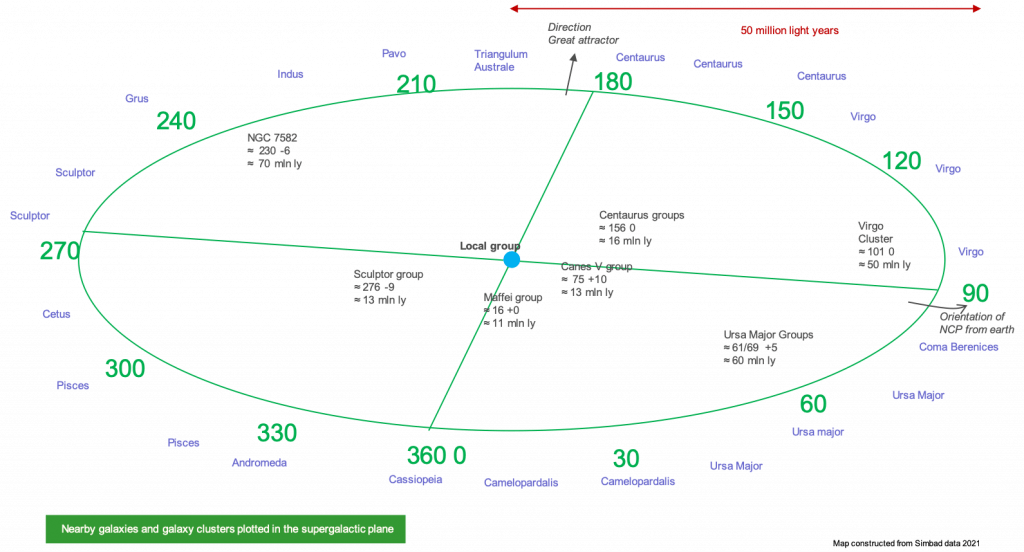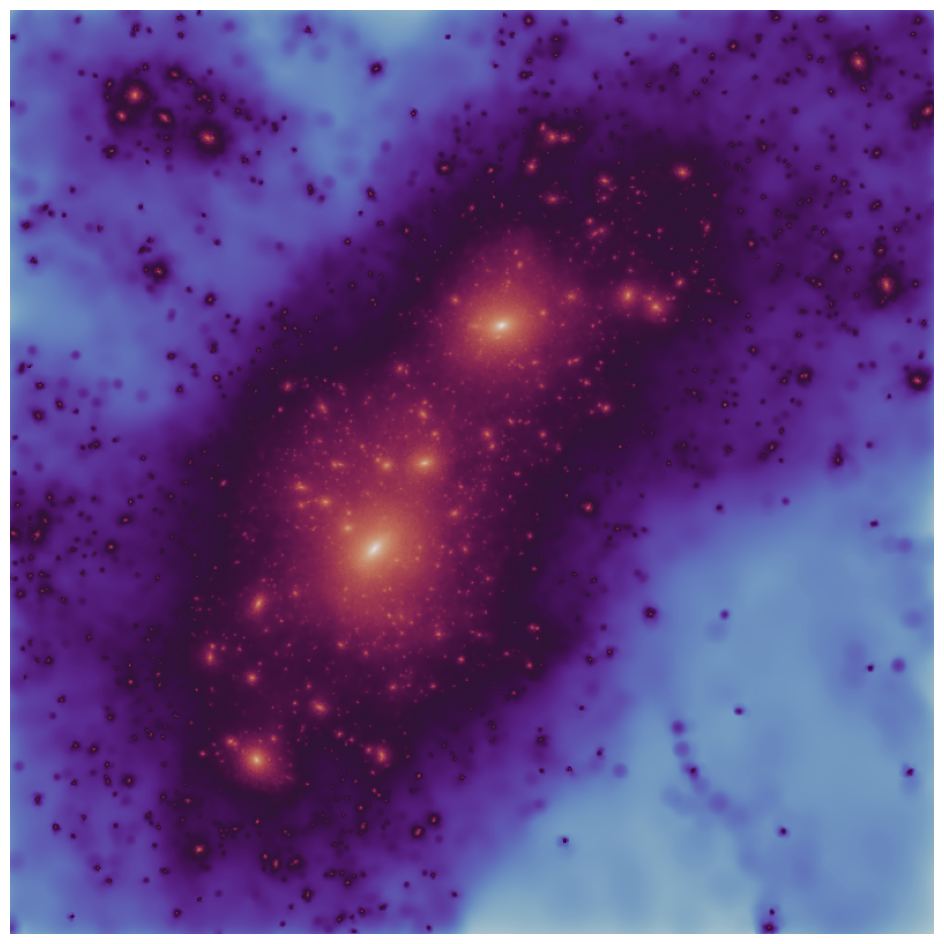The Milky Way is a barred spiral galaxy, maybe even a grand design spiral galaxy. We can’t be sure from our vantage point. But one thing is certain: there aren’t many disk galaxies like it in our part of the Universe called the supergalactic plane.
We can locate things on Earth using compass points and latitudes and longitudes. But in space, that doesn’t work. Astronomers use the supergalactic coordinate system to describe where galaxies are.
Part of that coordinate system is the Supergalactic Plane (SGP), which contains the Local Group of galaxies that the Milky Way is in. The SGP is nearly perpendicular to the Milky Way’s plane.

The exact nature of the SGP—its dimensions, its shape, and its relation to other cosmological structures—isn’t certain. “The structure of the SGP is not well described by a homogeneous ellipsoid,” a team of researchers wrote in their 2000 paper in MNRAS, adding that “the structure changes shape with radius, varying between a flattened pancake and a dumbbell.”
But scientists do know that the SGP is filled with galaxies. Bright elliptical galaxies dominate the SGP, while spirals like the Milky Way are rare. The paucity of spiral galaxies caught the attention of a group of researchers from Europe. They used supercomputer simulations to try to gauge the population and distribution of galaxies in the SGP.
The results are published in Nature Astronomy in their paper “Distinct distributions of elliptical and disk galaxies across the Local Supercluster as a ?CDM prediction.” The lead author is Till Sawala, from the Department of Physics at the University of Helsinki in Finland. Sawala was formerly associated with the Institute for Computational Cosmology at Durham University in the UK.
“Galaxies of different types are not equally distributed in the Local Universe,” the researchers write in their paper. “The supergalactic plane is prominent among the brightest ellipticals but inconspicuous among the brightest disk galaxies.” That striking difference sets the stage for their research, which is aimed at testing our understanding of how galaxies form and evolve, and if their formation and evolution conform to the Lambda CDM model.
The researchers used SIBELIUS, which stands for Simulations Beyond the Local Universe, to probe the nature of the SGP. In their words, they intend to “confront the predictions of the standard Lambda Cold Dark Matter (?CDM) model and standard galaxy formation theory with these observations.”
SIBELIUS is aimed at connecting the Local Group to its cosmic environment.

One of SIBELIUS’ strengths is that it can show how small perturbations can change larger-scale outcomes. Previous SIBELIUS simulations showed that the presence of the Large Magellanic Cloud affects how the Milky Way and Andromeda (M31) orbit each other as a binary galaxy pair.
But that’s just some explanatory backdrop for the new research.
SIBELIUS can simulate the Universe from its birth over 13 billion years ago up until now. In these current simulations, Sawala and his colleagues found that the distribution of ellipticals and spirals is because of the different conditions inside and outside of the SGP. Inside, galaxies are more tightly packed together, and outside of the SGP, the galactic density is lower.
Inside the SGP, galaxies interact and merge with each other more frequently. These interactions change beautiful spirals like the Milky Way into ellipticals, which are basically ellipses or spheres with no discernible arms.
But outside of the SGP, galaxies interact less frequently. So the Milky Way and others like it are able to retain their form.
“We find that SIBELIUS DARK reproduces the spatial distributions of disks and ellipticals and, in particular, the observed excess of massive ellipticals near the supergalactic equator,” the researchers write.

The SIBELIUS results are in line with observations, which helps confirm its usefulness. “This mass difference agrees with observational studies of galaxies in the Local Universe, which also find that the most massive galaxies are overwhelmingly elliptical,” Sawala and his colleagues write in their paper.
To grow large, disk galaxies like the Milky Way need a supply of gas and minimal interactions with other galaxies. That environment is found outside of the SGP. “We conclude that the environment prevailing in the supergalactic plane inhibits the conditions necessary for massive disk formation: a quiet merger history and the continuous supply of cold gas,” the authors explain.
So what do these results tell us about the Lambda Cold Dark Matter (CDM) model? That model is cosmology’s current standard model. It says that 27% of the Universe is dark matter, while 68% is dark energy, and only 5% is baryonic matter, or regular matter that constitutes stars, planets, and even us. Cold refers to the fact that dark matter moves much more slowly than the speed of light. Dark refers to the fact that it barely interacts with regular matter or electromagnetic energy.
According to Sawala and his co-authors, these results help confirm the Lambda CDM model. That’s because SIBELIUS is based on our understanding of the Universe, including CDM. So if it reproduces what we see, it helps confirm CDM.
“The strikingly different distributions of bright ellipticals and disks in relation to the supergalactic plane do not require physics beyond the standard model,” they write. Instead, the distributions relative to the SGP “arise naturally in the Lambda CDM framework.” The distribution is a part of the standard model of how galaxies form and evolve.
For us, it doesn’t make much difference whether we live in a spiral/disk galaxy or in an elliptical. But examining how our type of galaxy fits into nature is worth exploring. These results strengthen the already powerful arguments in favour of the Lambda CDM model.
Now, if we could only figure out what the heck dark matter actually is.


Quite helpfully some illustrations place the Supergalactic Plane in relation to our supercluster Laniakea, it spans a nearby high density region over most of Laniakea as its galactic velocity-flow goes away from the Shapley, Coma and Perseus-Pisces supercluster [“How flowing galaxies revealed the immensity of the Laniakea Supercluster”, Brent Tully, Physicsworld].
If I remember correctly it has been proposed that Milky Way is a rarity because it is large to sit close to our Local Void sheet. But in this context its (and perhaps Andromeda’s) spiral structure seem to have been protected by that.